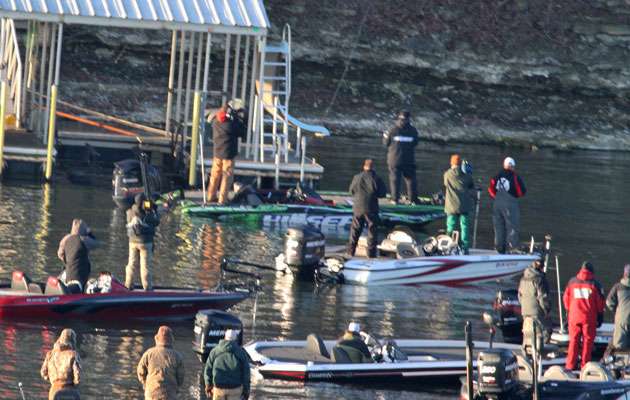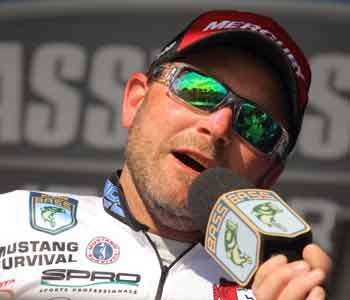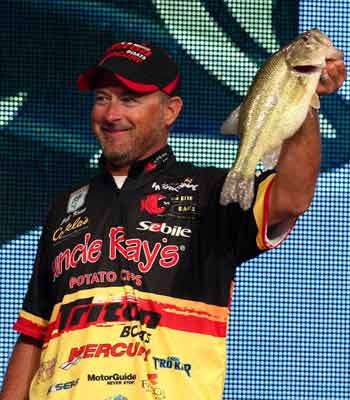
Any Classic qualifier who waited until the last week to scout did themselves a great disservice, Elite angler Mike McClelland said. “They put themselves in a real, real, bad situation.”
McClelland knows Grand Lake O’ the Cherokees, site of this year’s GEICO Bassmaster Classic presented by GoPro. He lives nearby in Bella Vista, Ark., and was among the favorites there at the 2013 Classic, when he finished fifth.
McClelland and fellow Elite Jeff Kriet of Ardmore, Okla., both of whom missed qualifying this year, were asked last week what the Classic anglers hoped to accomplish in prepractice before the lake went off limits at midnight Dec. 31.
First, they said those who put off the trip to Oklahoma until the last week probably didn’t get much accomplished. It rained for three consecutive days at Christmas, causing extensive flooding.
“That really put a damper on practice,” McClelland said. “It’s probably at a record high. It doesn’t even look like itself. All they’re looking at is willow trees flooded with 10 or 12 feet of water. They’re really not getting a good look at the lake.”
Those who came earlier got a much better take. Many anglers visited in early December, Kelly Bostian of the Tulsa World reported in this story. They worked on determining areas they’ll check once official practice begins before the March 4-6 event.
Kriet offered what he’d do.
“I would be running in a lot of the creeks and marking channel banks, channel swings and transition banks,” he said. “That time of year, fish get caught on those channel banks and swings, and I’d be marking them all over the lake so I would have options.”
Both Kriet and McClelland said Grand Lake is different than many of the other recent Classic fisheries. Those events were determined by finding that one winning area. Grand Lake allows anglers to pattern fish.

“The neat thing about Grand Lake, once you figure out how to catch ‘em, you can probably do it in that whole section of the lake,” Kriet said. “You could literally run fresh fish every day … not constantly beat on your fish.”
So breaking down the lake involves searching for desired features, marking them on their maps and making notes. McClelland said competitors might meticulously idle the entire day and never make one cast.
“These guys are literally covering miles of shoreline, even some guys do high-speed looking,” he said. “They basically cover the whole lower end of the lake, or the whole upper end of the lake.”
McClelland said most will idle between 3 and 5 miles per hour while graphing with their sonar units, taking advantage of their sideview and downview to locate specific areas. An angler could cover 50 to 60 miles in the course of a day.
“There are guys who will literally look at every nook and cranny of the lake,” he said. “There’s other guys who will try to narrow the lake down into specific areas that they feel confident in and try to eliminate sections of the lake they might not be so excited about fishing.”
The specific target spots include brushpiles, rockpiles and any isolated targets on the bottom in key pre-spawn areas. Kriet said Grand Lake is rocks and docks, and he thinks it’s beneficial to mark transitional banks with detailed notes.
“It may be a deal where it goes from bluff to chunk, or from chunk to pea gravel,” he said. “I would just want to familiarize myself. I would just want to identify the key places in the creek … I have to like the way a creek feels to me. It’s got a lot of the right options, that’s what I’d be looking for.
“And a lot on that lake could be as simple as the angle of the banks. They might be on a steep bank, or I need to be fishing 45-degree banks. That can be huge.”
The weather also will play a major factor, and not just the week of the event. The prevailing thought is that since the Classic dates have been moved back two weeks, the weather will be better than the freezing conditions that greeted anglers in several recent Classics.

“No, it could be colder,” Kriet said, noting the proclivity of ice storms in March. “This could be a crazy Classic. There’s absolutely no guarantee of anything.”
The weather could throw anglers a curveball, McClelland said. Moderate temperatures could have fish transitioning to more of a prespawn scenario. In that case, he’d recommend looking for the prime spawning areas.
“I’m not saying the fish will be spawning, because I think we’re way too early for that,” he said, “but if we have a mild winter and early spring, I think the fish can be pushing shallower than they were three years ago.”
The current flooding will have an effect on the event, even though it’s three months away. McClelland said Grand Lake’s water level can be managed very well, especially if it doesn’t continue to experience major rains.
“Does the floodwater have an effect on things? It could,” he said. “It actually could be beneficial. In my opinion, any time a lake gets a good flush, it just makes it a healthier body of water.
“It’s actually going to take a lot of pressure off the fish for at least the next month because the water conditions will be so poor for fishing. We could see bigger numbers and bigger weights caught in this year’s Classic due to the flood we had this winter.”
Kriet said there are factors that can make fishing really good, and a lot that could make it horrible. An ice storm or severe cold front, which are known to hit Oklahoma in that timeframe, could shock fishing to a halt.
“The bottom could fall out and the water temperature could drop 10 or 12 degrees overnight if you get a cold rain or some ice,” he said. “Then the shad will be dying, it’ll be muddy. You’ll be hard-pressed to catch a bass. That’s the worst-case scenario.
“Best is stable temps and water normal, or a little high and it clears up. Even if it’s cold and the water’s not muddy, they’ll catch them. The perfect storm would be for it to have a little color to it and it to get real warm.
“Now they’re going to catch them on a spinnerbait, on a squarebill, flipping. The fish are going to be shallow and they’re going to be pretty easy to catch, and they’re going to be big ones.”

